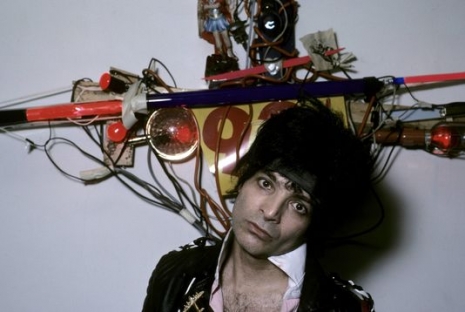
Alan Vega the solo artist and lead singer of the groundbreaking synthpunk duo Suicide who passed from this mortal plane almost exactly one year ago (7/16/16) is not done with us just yet and this is the best news I’ve heard in ages…
My own personal experiences and encounters with Alan Vega are varied, and over many decades, sometimes very near and sometimes far away, but always intense. Not like scary movie intense but like escaping death intense. As an innocent 16-year-old going to Max’s Kansas City in 1976 determined to get in “this time,” and being very under age, everything lined up right: my parents went out for the night and I got a friend from school to go with me, but the bands I knew about (Ramones, etc.) weren’t playing but anything would have been good.
Back then every band played two sets each night. We got there right on time for the early show and saw a band called The Cramps playing their third gig ever! (That is a major revelation I have gone into elsewhere many times). When Suicide hit the stage it was not packed but pretty crowded. I had been very into weird music for many of my young years but nothing on earth—I repeat, nothing—could prepare me for what I was about to go through. I had seen “bands.” And for God’s sake I had just seen The Cramps for the first time, but two guys come up, NO guitar, NO bass, NO drums and SCREEEEEEEEEEEEEEEEEEGH#%&*#!$#@ PLAY THE LOUDEST THING I HAD EVER HEARD!!
I had never seen a band with “no” instruments and they were louder than any band WITH instruments. I had never been literally scared of music and people I paid to “have fun” watching. By this point the singer was bleeding from pummeling his own face with his microphone. And it just got louder and louder. Vega would lean into the audience and people would run to the bar! I was mesmerized. I was glued to my seat. I went into another galaxy and I was changed forever. My friend was long gone, outside I found out, and he’d been outside since thirty seconds after they’d come onstage. This in itself was the dividing line between myself and the rest of my entire world as I knew it. The deciding factor that I needed to exist in THIS world and not the world I had known up until this point. This was a gigantic psychotic green light that I had never known existed but was waiting for my entire young life.
Between the Cramps and Suicide I had found my heart and soul. And I wanted more. And I have never for one moment stopped searching for that something “more.”

By the 1990s I had followed this path for quite a while and was familiar with and friends with many of these people, and was one of them. When my band D Generation was recording our second LP No Lunch at Electric Lady studio with producer Ric Ocasek, chosen much for the fact that he could work with Suicide and The Bad Brains (musically AND personally), the idea came up for us to have Alan Vega pay a visit. Once there, we thought he’d be tickled about a song we had just finished called Frankie about a tough cross-dressing punk type, a sort of homage to his Frankie Teardrop. Next thing you know he is in the studio recording a vocal. All I can think about was that first life changing night at Max’s Kansas City which was then twenty years prior (now forty one) as I watch and listen to him give Ric and the engineer instructions to take all the music out except the kick drum, the bass (yay!) and Jesse Malin’s vocal. He then went to work squirming and shrieking and saying all kinds of wild heavy stuff. It was truly a privilege to be a part of that.
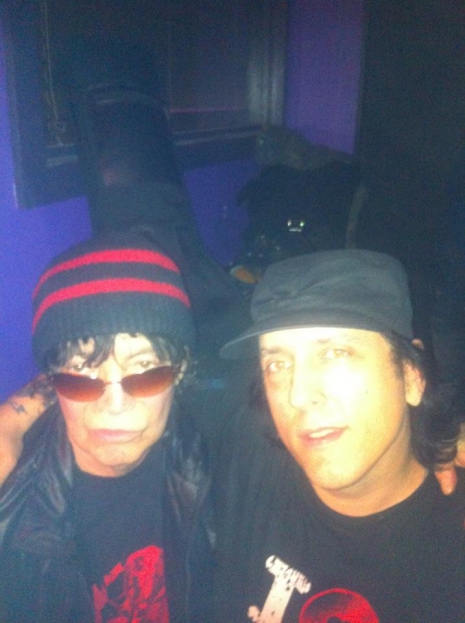
The author with Alan Vega
After that we knew each other better. Jesse brought him to meet Bruce Springsteen and Alan and Jesse became close. Alan once did a set doing the first Suicide LP live at Jesse’s club Bowery Electric. Jesse’s sideman Derek Cruz (with my help or at my suggestion I believe) sampled all the sounds from the LP and played the sounds on pads so it sounded exactly like the record! Amazing! But not exactly as planned as the sound man didn’t know the record and since I did (and I knew the soundman) I ran into the sound booth and asked him where the echo was and to turn it on and I did the echo frenzy on Alan’s vocal just like the record throughout the show. His beautiful wife Liz Lamere thanked me, as did audience members. That was a perfect experience to bring my life as far as Alan Vega is concerned to a perfect circle.
Until now.
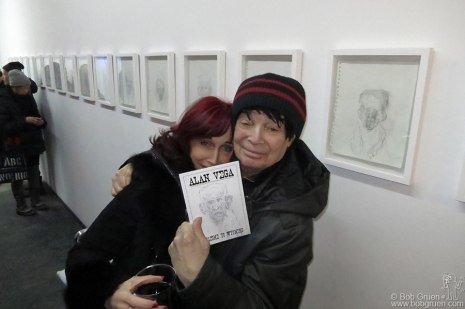
Photo by Bob Gruen
Almost a year to the day after Alan Vega passed he has sent us all a massive electronic slap in the face. And like the first time I was exposed to his music, it is harsh, exciting and necessary. Electronic meditations on sorrow, loss and darkness from the Suicide king. The new album, titled IT hits the streets on July 14th and is truly a message from beyond. IT can be downloaded digitally and bought on vinyl, with a 2-LP gatefold including unpublished drawings, writings, and photos by Vega. The digital album is now available for pre-order here, and the standard vinyl can be pre-ordered via Amazon.com here. A special limited release of IT will also be available on transparent orange vinyl, sold exclusively at select indie retail locations, the list of which will soon be announced.
Leading up to the one-year anniversary of Vega’s passing, New York City will host a series of events deemed “Alan Vega Week” including exhibits and performances in Alan’s memory. On June 30th, INVISIBLE-EXPORTS opened an exhibition featuring Vega’s historic light sculptures, as well as his final series of work including acrylic and graphite paintings. Depictions of a single mythical man, they also form, together, a shifting, serial self-portrait. Additionally, on July 18th, Jeffrey Deitch will open “Dream Baby Dream,” a memorial exhibition commemorating Vega’s life and work, including video projections of historic performances by Suicide, and a selection of Vega’s sculptures and works on paper from the 1960s to his last works in 2016. Stay tuned for additional memorial events around “Alan Vega Week” to be announced.
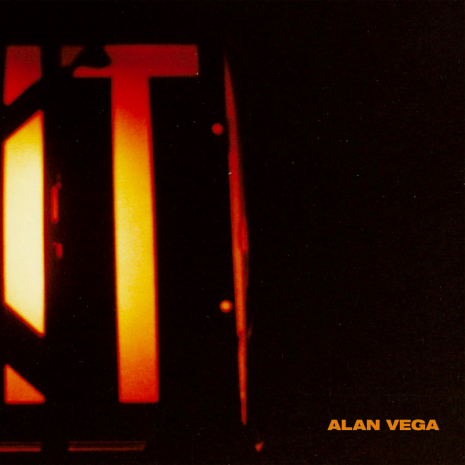
The album opens with its first single and video called Dead To Me. “Life is no joke/It’s days and nights-pure evil/Heyyyyy, sometimes the skanks save souls/DTM-dead to me.” Over a pounding atonal electronic repetitive groove, it is relentless, bleak and very heavy. Spitting out lines of endtimes doom and truth, it’s a tough pill to swallow. But surely one worth forcing down.
It’s so hard to pull quotes from this album as every line is more incredible than the last. Here’s a few that struck me (as I understood them).
From “Vision”:
If you destroy the vision, you will suffer the whirlwind
This is no circus act
If you violate the kingdom come
It’s the day the music stops
From “Screaming Jesus”
The red, white and blue is destroyed
There’s no more-just war-war-American war
Screaming Jesus
(The music sounds like thousands of July 4th firecrackers exploding at once.)
From “Motorcycle Explodes”
It smells of misery
And goddamn rivers of blood everywhere
Damn gasoline is burning agony
The skull is dead
Ferocious deadly blast
It kills in seconds
The truth is dead
At rocket speed
Gone… gone… gone…
From “Prayer”
Acceleration
A meditation
A war is over
For a broken soldier
Returns
Hallelujah
A prayer for the broken soldier
Say your confession
At galaxy speed
Pray, oh pray for redemption
From “Prophecy”
I will get up
I will survive
I will go on and on
So fuck you killers
FUCK YOU!
I stand-I stand
It’s my prophecy

Beginning in 2010 until the time of his death in July 2016, Vega wrote and recorded IT along with his wife Liz Lamere in New York City. I emailed with Liz at length about a few angles that I was curious about.
Howie Pyro: What was Alan listening to before/during the recording?
Liz Lamere: Alan mainly listened to soundtracks on the TV—movies, ads, sports, TV shows (he loved Bluebloods, Breaking Bad and Longmire), independent films, documentaries, all sources of news programs. He was well versed in the complexities of the conflicts in the Middle East and knew all the political players as well as sports teams and players– some good analogies here, but beyond the scope…
Until his physical problems slowed him down, he walked around the financial district late at night, and near the Brooklyn Bridge, by Battery Park and took photos and recorded sounds (in the street, in the subway). He had no interest in owning a cell phone, or using a computer (other than in the studio) and had zero exposure to social media or popular music other than by osmosis (mainly on TV or in the street). His private music collection was classical, jazz and some rap. When anyone sent him a recording it was not easy getting him to listen and then he’d do so for maybe 30 seconds. He had no interest in knowing what was “current” or the names of genres. He hung out at the Blarney Stone or Killarney Rose for about an hour after midnight, to have a drink with the working class guys, then come home to draw portraits, write, listen to the most recent studio recordings, work on a sculpture or painting. There had to be a very good reason (like a benefit or a special gig or shows in Europe ) to get him into a music club.
How much of the album was recorded near the end of his life?
This is also a complicated answer (smiley face). A lot of the sound tracks were recorded from 2010 – 2012, and then he was sidetracked by a stroke and art shows in Paris in 2012. During the period, 2010-2015, Alan, Dante and I were doing annual concerts in Europe, mostly Paris (road testing tracks from the evolving IT). The last time we performed songs from IT was at the Barbican in London July 2015 / Moog festival (Alan and Marty each did a solo set and then a Suicide set). Each time we’d come back from doing shows, we’d do some tweaking, or tracks would be added or subtracted. He also did a crazy stripped down minimal version of IT in 2014/15 pulling out all but 2-3 tracks for each song (we have that version in the vault and it’s brutal). We did final mixing (there were infinite possibilities) in 2015-2016.
By way of further background: When listening to the lyrics and how relevant they are to our present political climate, it is surprising to note that the vocals were recorded at the end of 2011! Alan wrote religiously every night – then when a recording was near done, would pick lyrics (that were often prescient). His solo album that came out prior to Sept 11th, foreshadowed the attack, and starting in early 2001 he was making hanging memorial artworks that looked eerily like those that later formed at “Ground Zero.” When people saw them in the 2002 Deitch show they assumed he made them post 9/11 as a nod to the memorial.
It is also highly unusual that Alan would record vocals when the album was not in its final stages - he always picked lyrics from his writings and recorded vocals last. However, during much of 2011—2012 he was preparing art works for a major showing at the Laurent Godin gallery and solo booth at the FIAC international art fair in Paris. So, in late 2011 he decided to record the vocals for the album that was taking shape, before he began to focus almost entirely on the art in anticipation of the fall 2012 shows. It was also fortunate that the vocals were completed before his stroke May 16, 2012—he was 73. The stroke made it hard for him to speak and find words for some time – that improved over time and singing was easier, but still… At the time, he also had a minor heart attack and the doctors discovered he had severe congestive heart failure. Even though they got a stent in the only artery not over 90% blocked, because both of the carotid arteries leading to his brain were almost entirely blocked, they couldn’t attempt intervention without triggering a massive stroke. Alan lived from 2012 – 2016 with this knowledge, but he never let it stop him from creating. He never focused on it, only his art. Six months after leaving the hospital, he was in Paris not only for the art shows but performing a concert of songs from IT!
Side note 1: In 2009, Alan had a major retrospective at the Museum of Contemporary Art (MAC) Lyon and thereafter was represented by Laurent Godin of the Godin Gallery in Paris, and his works were gaining significant recognition in Europe. This led to the shows in 2012. He had never stopped working on the art from the early 70s (he studied art at Brooklyn College with some key artists, Ad Reinhardt and Kurt Seligman). Alan never sought out galleries to show his works (Ivan Karp/OK Harris “discovered” his work at the Project of Living Artists and started to show him). After his shows at OK Harris and Barbara Gladstone in the 70s-83, he signed with Elektra Records and the music started taking more of his time and he stopped showing. Then in early 2001, Jeffrey Deitch discovered he was still doing the art (after his gallery staff had seen a Suicide show at the Knitting Factory and told Jeffrey how incredible they were). Deitch tracked us down, saw the apartment filled with works, and asked him to exhibit – hence the “Collision Drive “ exhibition at Deitch Projects in 2002 . Suicide ended the exhibition run with an awesome concert at Deitch (that will be shown for the first time as part of the upcoming Deitch exhibition)!
So, Alan got a bit sidetracked from the music in 2012. In April that year, he was honored by Artists Space (at which point Alan asked me “Did I die and they forgot to tell me?”) He always thought this type of recognition would only come after he was dead and it really creeped him out. He was more stressed due to that event then I’ve ever seen him. Also, until he turned 70 everyone (including himself) thought he was ten years younger and that “reveal” birthday party hit him hard. Then, when he was 71 he was robbed and beaten up pretty badly in the street by Battery Park (on a 2am walk). This felony assault required 25 staples to close the back of his skull and thirteen stitches on his forehead—but he managed to get up and walk home several blocks to get back to me and an ambulance (he alludes to this in “Prophesy”). Then two years later came the stroke. Meanwhile, he got up and went on and on to finish the art for the show and the concert and we flew to Paris 6 months later.
Side note 2: From about 1988 until 2016, Alan and I recorded only 7 albums together – however there is a substantial library of unreleased music. During this period we went into the recording studio about 3 nights a week – like going to the gym - (less for me when Dante was a baby). The goal was mainly to create sound - a very different process from having songs written and going in to “record an album.” Everything happened spontaneously in the studio and sometimes hours would be spent finding and /or morphing one track. Except for some drums—the vast majority of tracks on IT (and most of those records) do not come straight out of a machine or conventional instrument. Much that sounds like loops on the early records is played by hand (smile face). For instance, on IT there are no guitars, just sounds that may sound like that and may actually have started with a recording of a motorcycle engine, or the blender, or a radio static, then run through a series of effects, etc. Every few years or so an industry person (usually Paul Smith, Mute / Blast First) would ask if there was a new album and we’d then focus in on pulling sounds into 9-11 cohesive tracks that worked together as a conceptual whole—we’d make an album! In addition to helping create and/or morph some of the sounds, my role as producer was in being the “General”—getting to commitment on finalizing songs and most importantly getting Alan to record vocals for the album. Ironically, vocals was the last thing he wanted to do—he could keep morphing sound tracks for ages but vocals were usually one take performance and the lyrics and performance had to be 1000% commitment, because he was laying it all on the line in that moment. The beauty of working with Alan was that there were no “mistakes” and no expectations; but he must have felt pressure on himself with the choice of lyrics. He would avoid it like the plague until he got in that vocal booth and Perkin (the engineer) and I would listen while the magic happened and our jaws would drop. Then we loved mixing (and had the best fights during that process) and we could get lost for eons in the mix, so again I had to exert some control. Also if it were totally up to Alan it could be almost unlistenable (smiley face).
So, because the pattern was for each album to evolve over the course of years, we have quite a large library of unreleased sound (and some vocal tracks) but that’s another story for the future!
Did Alan have any culture nostalgia or was he always looking to the future artistically?
As far as his own creation and life journey, Alan rarely looked back. And, he didn’t like revisiting the 70s at all. It was very hard at first for him and Marty to agree to perform the first Suicide album for the series of concerts they did later in life. He had nostalgia for early rock n roll (Gene Vincent, Roy Orbison, Elvis), the jazz masters (Miles, Coltrane, Albert Ayler) old school hip-hop and rap, but very little for his personal history (other than some favorite memories—especially crazy tour episodes). When it came to creative inspiration, he was absolutely and always looking to the future, searching for new ways to express his vision and create unique sound.
As Elektra discovered, his constant re-creation of his sound made it hard to market him as a major label artist—there was no predictable reproducible formula. His purpose was to break the mold not mass produce it. That’s one of the reasons he lost interest in producing the light sculptures to show when Barbara Gladstone started selling them in the 80s and wanted him to keep showing. It’s why he was stifled by the major label when they brought in top producers to help create the “hit” sound and make him a rockstar – that was the death knell and his salvation. When I met him just as Just a Million Dreams was coming out – he was living at the Gramercy Park hotel with a series of light sculptures on the wall and a crazy linked up array of effects pedals on the floor making really weird and beautiful sound. He was so incredibly passionate about his quest for the next creation. He called himself “the research scientist in the basement.” He rarely listened to his own past music. Jesse Malin can tell you a story of when he went to see Bruce, and after the show Alan’s song “Dujang Prang” came on… Alan turned to Jesse and said “Hey I like this, who is it?” And Jesse said, “Alan, it’s you!” I’m pretty sure he hadn’t listened to that song since we did the final mix. He wouldn’t even listen to (or keep ) the records sent to us when they were released.
Did he have a message to this crazy world or want the public to know anything we wouldn’t understand from his art about him or his world view?
I think the casual observer may not know how deeply creative Alan was, and that truly was his life purpose. He had almost no material needs or the need to define himself by outward signs of “success” or acquired status symbols – I loved that about him so much! He was a brilliant man. He was majoring in physics at Brooklyn College when Kurt Seligman saw him doodling in a text book and told him he should be majoring in art!
Alan knew that the world was pretty fucked up, but it didn’t scare him or cause panic. He was a survivor. Even sitting in our apartment blocks away from Ground Zero on 9/11, as our neighbors were evacuating, Alan hunkered down: “They’ve blown their wad, we’re safer here than going out into the toxic air” We watched the events unfolding on TV as if it wasn’t happening in our backyard. He had already been a child of the Depression era, his parents were Jewish immigrants, his first wife Mariette Bermowitz (married from 1960-70) was a Holocaust survivor. Suicide formed out of the squalor of a bankrupt NYC, the horrors of Vietnam (and the mostly deplorable welcome home vets received), and the corruption of the Nixon era. They were not in the mood to entertain and feed escapism – Alan and Marty were giving the audience a taste of real life, the good, the bad and the ugly.
So, with this backdrop it took a lot for Alan to feel hopeless about the future. Human suffering and war and evil has existed since the beginning of time as we know it. He was fascinated by the circus of the election – called Trump “the Archie Bunker of our times,” and I don’t think he would’ve been surprised that he won the election – for a variety of reasons, but beyond the scope here. Bottom line, he wouldn’t panic, he’d tell us stand firm in our beliefs and focus on the things we can do to make positive change and not lose sight of our values. The greatest beauty often comes from adversity. He would look for the common ground, the universal truths that bind us together as humans. His art, in every form it took, tapped into the collective unconscious that exists in the universe, and brings to bear all the energy of all those who have come before us. It’s where Alan resides now. His art was a catharsis for him and captures the spectrum of human emotion. The portrait drawings he did daily, the “self portraits” are also “everyman,” and you can feel ancient wisdom there—that is why they were always rendered as elderly. His visual art, like his music, is not straightforward—not prose, but poetry; leaving it open to interpretation by the individual in any way that gives them what they need from it. Only you have the answer to what it really means. He loved that each person seeing his art or hearing his music and words could find their own meaning from it -whatever they needed. And that gave him great joy. I think the message of his art and music can be found in the words to the final song on IT called “Stars” which he said is the anthem and final message to this planet:
“It’s yours, It’s your life, your given hand, your final hand, the Power is given. They give you the Universe, it’s all yours, for free. Do what you want, anything, anything. The ocean, your river, your mountain majesty, the land, the stars, for free, it’s your life”
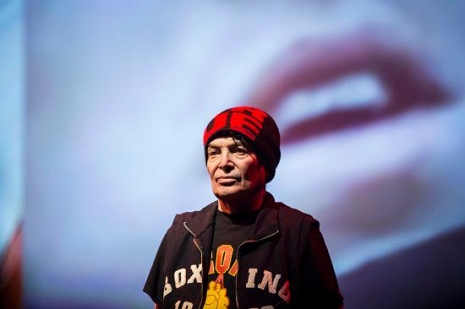
As I said earlier, this record is as harsh-sounding for today’s audience as Suicide’s first LP was in 1977! When The Clash took them on tour with them in the UK punk audiences were so upset by Suicide that they tried to kill them—every night! So did the teeny bopper American fans of The Cars when Suicide toured with them. It was not easy but it had to be done. This new record is THAT heavy, if not more so. Get IT now, before it’s too late.